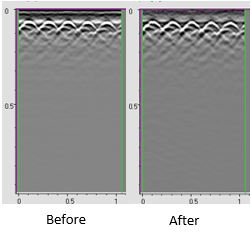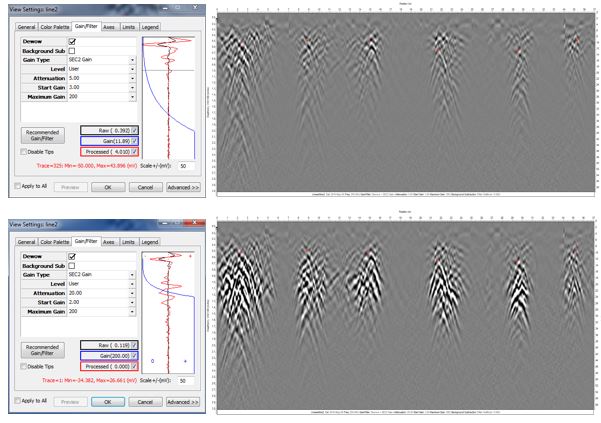How to Locate Defects in Concrete
This blog will discuss the non-destructive testing methods that can be used to locate defects in concrete. It will also provide a brief explanation on the processing of GPR data.
We are excited to announce the arrival of our new Laarmann sieve stock. The sieves comply with the specifications set out by the world's most demanding Standards and we offer a variety of types and sizes. PCTE is pleased to be launching our YouTube Live channel. We are planning to host regular online presentations on important areas of non-destructive and materials testing. We launch May 11th at 12.30 pm with a presentation on the Non-Destructive tests mentioned in the recently released Bridge Code section AS 5100.8. Register now!
Defect Location in Concrete
Defects in concrete can occur during and after construction. During construction, bad consolidation can leave air voids, honey combing, or concrete may crack during curing. Visual inspection will not locate hidden flaws in a structure or measure the extent a visible defect projects into the structure.
Once a structure is constructed and accepted it may still develop defects, long term corrosion can cause delamination and spalling damage to structures. Structural support is also a concern with scouring of supporting earth due to underground water flow a risk.
Defect location testing systems often take advantage of different forms of sonic testing. Air voids or cracks interrupt or delay the passage of sound and make ultrasonic testing methods valuable and reliable. Foundations such as piles or builk footings can also house defects. In this article, 6 widely-used non-destructive testing methods will be discussed with the aim to locate defects in concrete.
Impact Echo
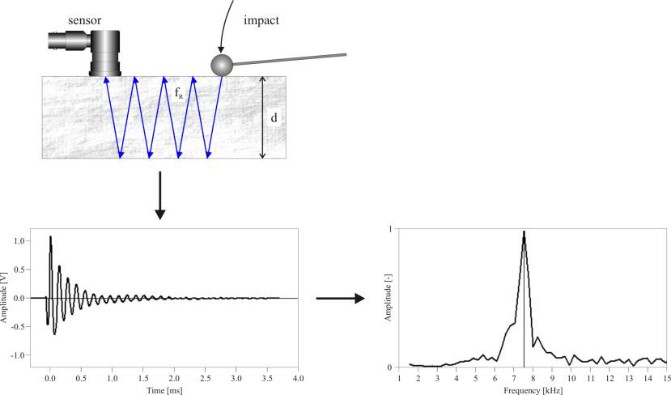 Impact Echo is an acoustic sounding technique. The operator impacts the surface which creates a broadband of frequencies transmitted into the concrete (i.e. 0-25kHz). The sound waves travel into the concrete and reflect where you have a change in acoustic impedance (i.e. density). The major reflections are generally due to air on the other side of the concrete, or in the case of voids or cracks, the air contained in these. The sound waves are reflected to a transducer sensitive the micro-vibrations as the sound wave bounces backwards and forwards. Signal processing is a high pass filter then applying a Fast Fourier Transform to the signal, showing it as a chart of energy over the frequency spectrum, the dominant frequency is inversely proportional to the thickness of the concrete (or the depth of the void/crack) d=bVp/(2f).
Impact Echo is an acoustic sounding technique. The operator impacts the surface which creates a broadband of frequencies transmitted into the concrete (i.e. 0-25kHz). The sound waves travel into the concrete and reflect where you have a change in acoustic impedance (i.e. density). The major reflections are generally due to air on the other side of the concrete, or in the case of voids or cracks, the air contained in these. The sound waves are reflected to a transducer sensitive the micro-vibrations as the sound wave bounces backwards and forwards. Signal processing is a high pass filter then applying a Fast Fourier Transform to the signal, showing it as a chart of energy over the frequency spectrum, the dominant frequency is inversely proportional to the thickness of the concrete (or the depth of the void/crack) d=bVp/(2f).
Impact Echo testing only needs access to one side of the concrete as it uses the echo of the sound wave. This is a distinct advantage from traditional ultrasonics.
Impact Echo has many application with regards to defect location and thickness measurements. It is important to realise that it is best applied to plate like concrete elements. Large slabs and concrete tunnel linings are ideal, whereas columns, beams and footings are not, especially testing along their longest dimension. Experienced users can use IE on such elements, but more carful data collection and interpretation is required.
Ultrasonic Pulse Velocity
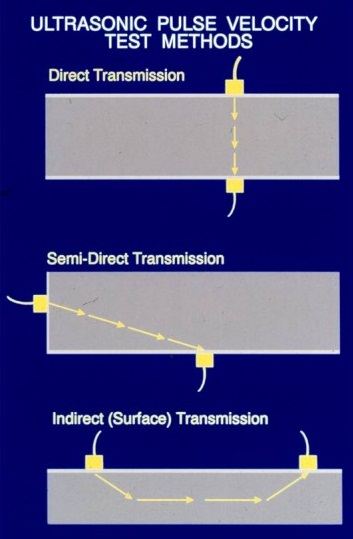 Ultrasonic testing in its most basic mode is called time of flight. This refers to timing the arrival of an ultrasonic pulse from one transducer to another through a solid medium. The UPV test typically requires 2 sides for access, one for a source and the other for a receiver. It is one of the most simply tests among other nondestructive evaluation methods. It measures concrete velocity along the path of the two transducers where their spacing is measured. This velocity has a direct relationship to concrete quality. The test can be done in several fashions: direct transmission where the source is opposite from the receiver, semi-direct transmission where the source and the receiver do not face each other or indirect transmission where the source and receiver are placed on the same side.
Ultrasonic testing in its most basic mode is called time of flight. This refers to timing the arrival of an ultrasonic pulse from one transducer to another through a solid medium. The UPV test typically requires 2 sides for access, one for a source and the other for a receiver. It is one of the most simply tests among other nondestructive evaluation methods. It measures concrete velocity along the path of the two transducers where their spacing is measured. This velocity has a direct relationship to concrete quality. The test can be done in several fashions: direct transmission where the source is opposite from the receiver, semi-direct transmission where the source and the receiver do not face each other or indirect transmission where the source and receiver are placed on the same side.
The UPV test can be employed to locate the presence of voids, honeycomb, cracks, discontinuities or poor quality concrete in general. For defect locating, it would need 2 accessible sides of the structures (at least semi-direct transmission) which allow the signal path to cross the area of interest.
Ultrasonic Pulse Echo
Unlike UPV, the UPE method commonly uses a dry point contact probe (no coupling gel required) and only one side of access is required to carry out the test. Good quality UPE devices are capable of void detection for flaws as small as 30 mm at 400 mm depth.
Pulse Echo is a method where the transducers act as transmitters and receivers, listening for the first echo arrivals from within the concrete. The transducers emit shear wave into the concrete element and those waves reflect when there is a change in material density. In the end, the reflected waves are captured by the transducers.
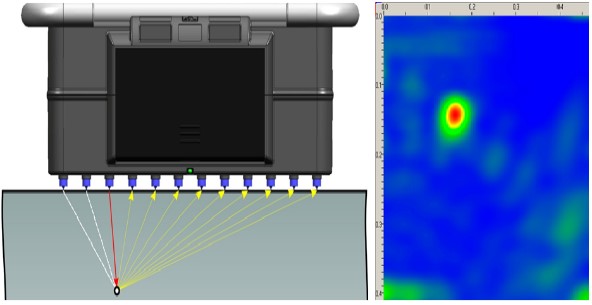 The ultrasonic readings are taken and analysed by the software to determine how many signals are reflected by different points in the concrete. The computer builds up an image of the concrete interior using SAFT processing. The different colours represent the intensity of the reflected waves. Sources of reflection can be different materials such as air voids (cracks, honeycombing etc.) within the concrete. Any included material interface may reflect a signal but certain interfaces reflect more strongly. Air concrete interfaces will reflect virtually the entire wave energy.
The ultrasonic readings are taken and analysed by the software to determine how many signals are reflected by different points in the concrete. The computer builds up an image of the concrete interior using SAFT processing. The different colours represent the intensity of the reflected waves. Sources of reflection can be different materials such as air voids (cracks, honeycombing etc.) within the concrete. Any included material interface may reflect a signal but certain interfaces reflect more strongly. Air concrete interfaces will reflect virtually the entire wave energy.
UPE can be used to locate void, honeycomb, poorly grouted pre-stressing ducts, construction joints, conduits and also the overall thickness of concrete elements.
Slab Impulse Response
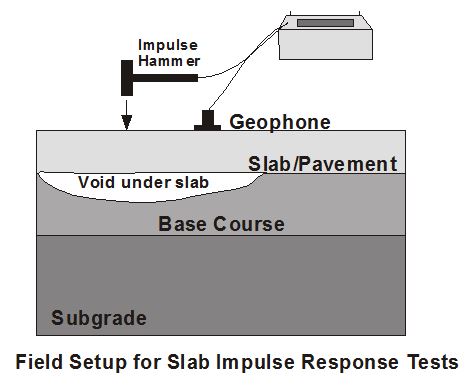
Slab IR uses a low-strain impact with an instrumented, rubber tipped hammer to send stress waves through the tested element. The element acts in a bending mode and a velocity transducer or geophone placed adjacent to the impact point receives this response. Both the hammer and the geophone are linked to a data acquisition system for processing and storage.
The time trace of the hammer force and the velocity transducer are processed into frequency using the Fast Fourier Transform (FFT) algorithm. Dividing the resultant velocity spectrum by the force spectrum then derives the "mobility".
The parameters used for the integrity evaluation are the dynamic stiffness, the average mobility and the mobility slope and the voids ratio.
Spectral Analysis of Surface Waves (SASW)
SASW is an acoustic method which measures the propagation speed of Surface/Rayleigh waves of various wavelengths. The short wavelength waves sample shallow section while the longer wavelengths sample deeper. This non-destructive test allows the measurement of the average velocity versus depth profile into the structure, which can be related to the strength and condition of the concrete at versus depth. SASW testing is also commonly applied to road base or soil layer analysis.
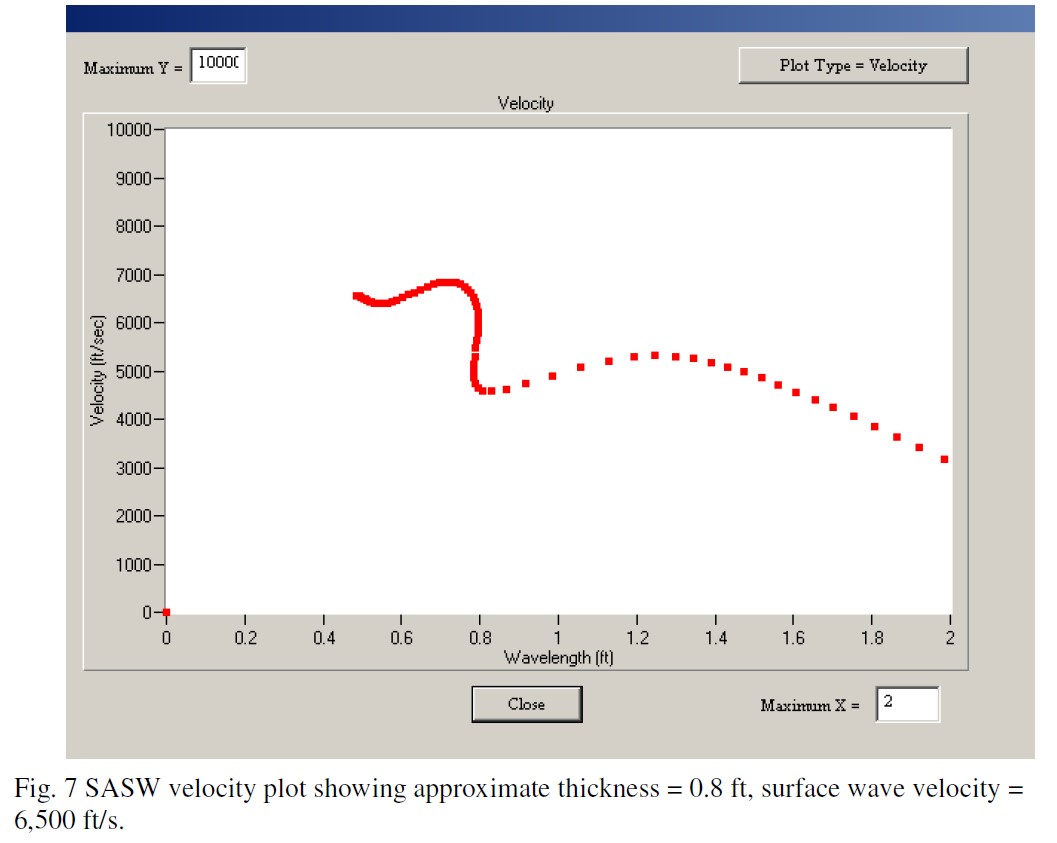 SASW testing is applied from the surface which makes the method non-destructive and non-intrusive. In SASW tests two receivers are placed on the surface and a hammer is used to generate the wave energy. An Olson Instruments' Freedom Data PC or NDE 360 records the hammer input and the receiver output. Short receiver spacings are used to sample the shallow layers while long receiver spacings are used in sampling the deep materials.
SASW testing is applied from the surface which makes the method non-destructive and non-intrusive. In SASW tests two receivers are placed on the surface and a hammer is used to generate the wave energy. An Olson Instruments' Freedom Data PC or NDE 360 records the hammer input and the receiver output. Short receiver spacings are used to sample the shallow layers while long receiver spacings are used in sampling the deep materials.
SASW testing has been used to evaluate concrete thickness, crack depths into concrete, the success of epoxy filling of cracks of joins and layer analysis of pavement systems.
Basic Processing of GPR Data
When viewed with no processing, GPR data is extremely hard to interpret. Most GPR systems process the data automatically for real time viewing. It’s important to understand the processing though, as mistakes can be made by the user when the methodology and each step of data processing's effects are not appreciated. This article will discuss a few of the basic processes that in most systems are applied automatically and some of the important aspects to them. It will show examples from the Conquest 100, LMX-200 and Ekko_Project software.
Zero Point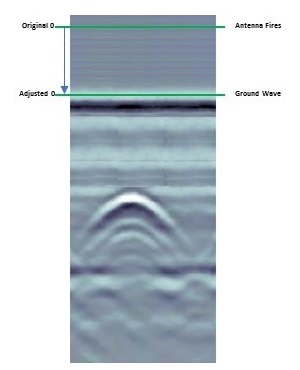
It is important to understand that the electromagnetic wave produced in the antenna during a GPR scan emanates from above the surface. This means there is a short period of time when the wave travels through the air until it hits the surface (ground or concrete depending on the application). The wave travels very quickly in air and so when viewed on a standard line scan (b-scan) it is quite a large band with no data. Then the wave hits the surface and the first portion of the energy is reflected at the receiver. This is generally called the ground wave.
This ground wave reflection plays an important part as it is this relative point in time that is used to determine the zero depth (time) for the scan. The depth inside the solid is determined from this point. It is hard not to use time and depth interchangeably because the GPR is measuring time and then the depth is calculated using an assumed velocity for the electromagnetic wave.
It needs to be understood that the wave in not an instantaneous event, it is a pulse lasting fractions of a nanosecond with both positive and negative polarity components. That means that determining the exact point in the reflected wave that represents the time to the surface is chosen arbitrarily. It could be in the first positive pulse or in the negative pulse after that.
In reality it doesn’t matter but it does affect how the scan is interpreted. For example, if the peak of the first positive part of the pulse is chosen as the zero point then when a reflection is noted in the line scan that same peak should be used as the depth of the target noted (ie the top of the target, as that is where the dielectric contrast occurs).
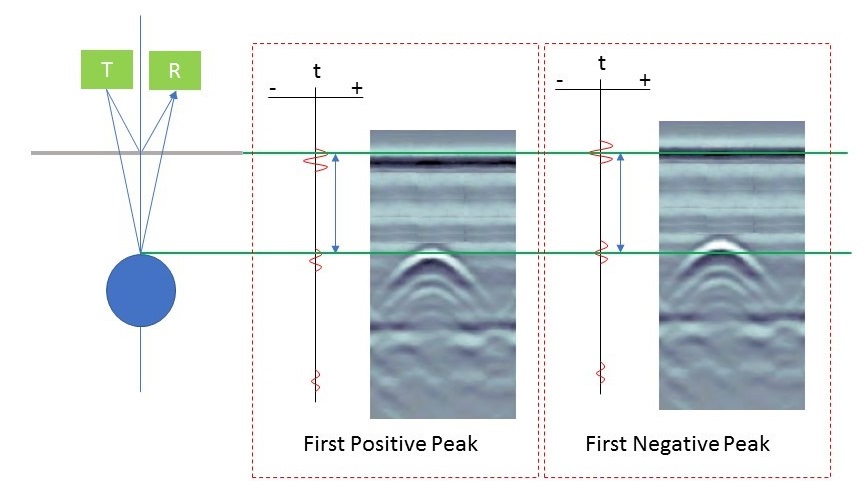
Background Removal
The ground wave can be very strong. It depends on the dielectric contrast at the surface of the solid (i.e. concrete or ground) in question. For example, a tiled surface or wet surface can exacerbate this effect. The strong banding caused by the ground wave can make targets more difficult to see. A simple process that is common to improve the line scan image is the background removal. The image below explains the situation. Subtracting the scan 2 from number 1 removes the first reflection from the resulting scan. In reality scan 2 is resolved from the average of a number of the scans. The ground wave appears on every scan resulting in the average being dominated by the ground wave.
The ground wave can vary in level and in intensity, particularly in scans performed on ground. The can be due to undulation, changing moisture level and also when moving from soil to asphalt to concrete surfaces. Post-processing software can allow you to vary the number of scans used in the average in the filter. Reducing the number of scans in the average can more effectively remove a variable ground wave.
Background removal processing will also remove other linear reflections that appear throughout a GPR scan at the same depth, such as reflections from an off form finished back side of a slab. If an operator is looking for linear reflesctions such as this he should view data both with and without background removal.
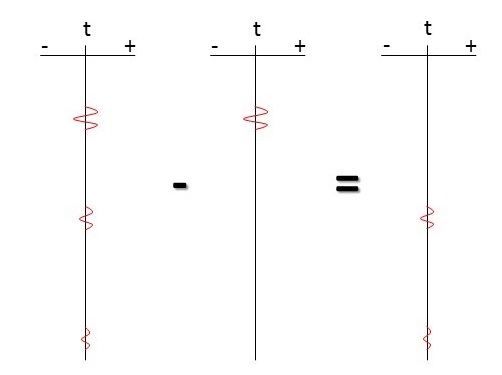
Gain
As electromagnetic waves penetrate further into a solid they will lose energy. The result will be that reflections from deeper will be weaker than shallow reflections. The data is processed using gain to amplify the signal to a higher amplitude with increasing depth. The figure below shows this graphically and the processing's effect on a line scan
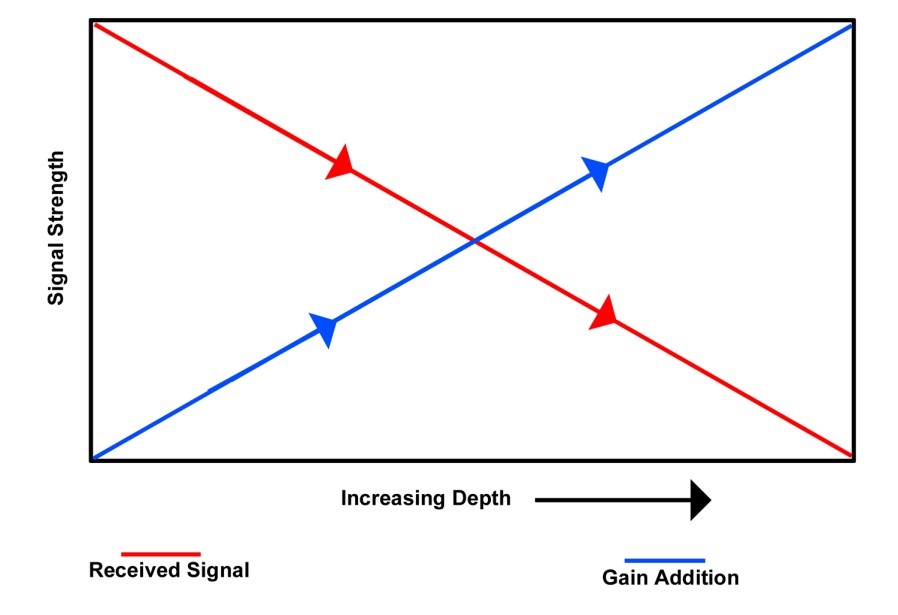 To assume that the energy reflection decreases linearly is a simplification. Therefore there are a number of gain functions that can be used. A common form of gain is the spherical and exponential gain compensation (SEC) which applies a linearly increasing time gain combined with an exponential increase in the gain (Jol and Bristow, 2003). The gain is defined by 3 factors. The start gain, max gain and the attenuation.
To assume that the energy reflection decreases linearly is a simplification. Therefore there are a number of gain functions that can be used. A common form of gain is the spherical and exponential gain compensation (SEC) which applies a linearly increasing time gain combined with an exponential increase in the gain (Jol and Bristow, 2003). The gain is defined by 3 factors. The start gain, max gain and the attenuation.
The two figures below demonstrate two gains. In both examples the gain factors are shown. The resulting gain function is the blue line in the setting, the black line is the ungained data and the overlaid red line is the data after the gain has been applied. The affect of both gain setting is shown as well. It can be seen that higher attenuation increases the function faster and so its effect happens shallower.
An additional feature of a well-set gain is that you may want to highlight a particularly depth.
Migration
Migration is a process whereby the hyperbolic reflections from targets are transformed into circular targets and hence more a more realistic image of the internal structure of the scanned medium. It is a mathematical process that involves using the velocity of the wave in the material and the spacing of each individual scan. The figure below sows the same scan before and after migration (amongst other processes).
Migration is one of the processes used in the grid scanning mode, where multiple scans are combined into a plan view image.
Care needs to be taken when viewing just migrated data. Targets called ‘artefacts’ can be created that do not correspond to real targets or targets may not be seen in this view also. Whilst the data may look easier to interpret, it should always be accompanied with the original line scan.


